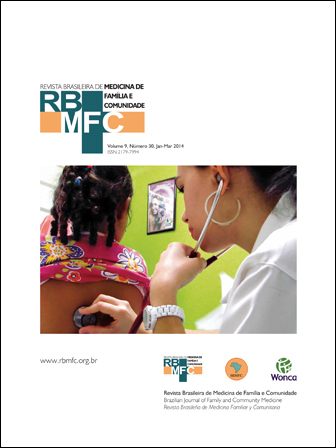Acne vulgaris: diagnosis and management by the family physician
DOI:
https://doi.org/10.5712/rbmfc9(30)754Keywords:
Acne Vulgaris, Therapeutics, Primary Health CareAbstract
Acne vulgaris is the most common skin disease worldwide. It affects 85-100% of the population at any point in life. Consequently, it is a frequent reason for primary care visits. It usually begins at puberty, reaching its peak between the age of 14-17 in girls, and 16-19 in boys, and it is more severe and prevalent in males. Although widely discussed, Acne vulgaris still requires constant updating. We conducted a survey of clinical guidelines, systematic reviews, and meta-analyses published over the past 15 years, concerning acne vulgaris and its treatment. Acne vulgaris is usually divided in three clinical types: comedonal, papulopustular, and nodular. The diagnosis is based on clinical signs; however, other conditions should be considered. There are several pharmacological therapies available, especially retinoids, antimicrobials, and hormone therapy, which should be used after considering its indications (type of acne and its severity) and side effects. Thus, the family physician plays a leading role in addressing acne vulgaris, from diagnosis to management of therapeutic options.
Downloads
Metrics
References
Figueiredo A, Massa A, Picoto A, Soares AP, Basto AS, Lopes C, et al. Avaliação e tratamento do doente com acne – Parte I: Epidemiologia, etiopatogenia, clínica, classificação, impacto psicossocial, mitos e realidades, diagnóstico diferencial e estudos complementares. Rev Port Clin Geral. 2011 Jan-Feb;27:59-65. DOI: https://doi.org/10.32385/rpmgf.v27i1.10821
Dréno B, Poli F. Epidemiology of Acne. Dermatology. 2003;206(1):7-10. http://dx.doi.org/10.1159/000067817 DOI: https://doi.org/10.1159/000067817
Thiboutot D, Gollnick H, Bettoli V, Dréno B, Kang S, Leyden JJ, et al. New insights into the management of acne: an update from the Global Alliance to improve outcomes in Acne group. J Am Acad Dermatol. 2009 May; 60(5 Suppl):S1-50. http://dx.doi.org/10.1016/j.jaad.2009.01.019 DOI: https://doi.org/10.1016/j.jaad.2009.01.019
Pawin H, Beylot C, Chivot M, Faure M, Poli F, Revuz J, et al. Physiopathology of acne vulgaris: recent data, new understanding of the treatments. Eur J Dermatol. 2004 Jan-Feb;14(1):4-12.
Carvalho A, Mourão A, Assunção C, Fonseca C, Gama D, Oliveira L, et al. Acne: prevalência e factores associados. Patient Care. Edição Portuguesa. 2010 Fev;15(156):59-65.
Mallon E, Newton J, Klassen A, Stewart-Brown SL, Ryan TJ, Finlay AY. The quality of life in acne: a comparison with general medical conditions using generic questionnaires. Br J Dermatol. 1999 Apr;140(4):672-6. http://dx.doi.org/10.1046/j.1365-2133.1999.02768.x DOI: https://doi.org/10.1046/j.1365-2133.1999.02768.x
Magin P, Pond D, Smith W, Watson A. A systematic review of the evidence for myths and misconceptions in acne management: diet, face-washing and sunlight. Fam Pract. 2005 Feb;22:62-70. http://dx.doi.org/10.1093/fampra/cmh715 DOI: https://doi.org/10.1093/fampra/cmh715
Gollnick H, Cunliffe W. Management of acne: general management strategies in acne. J Am Acad Dermatol. 2003 Jul;49(1):S30-1. DOI: https://doi.org/10.3109/9780203492642
Dunlap FE, Mills OH, Tuley MR, Baker MD, Plott Rt. Adapalene 0,1% gel for the treatment of acne vulgaris: its superiority compared to tretinoin 0,025% cream in skin tolerance and patient preference. Br J Dermatol. 1998 Oct;139(52):17-22. DOI: https://doi.org/10.1046/j.1365-2133.1998.1390s2017.x
Millikan LE. Pivotal clinical trials of adapalene in the treatment of acne. J Eur Acad Dermatol Venereol. 2001;15(3):19-22. DOI: https://doi.org/10.1046/j.0926-9959.2001.00008.x
Poli F. Soins cosmetiques et acne. Rev Prat. 2002 Avr15;52(8):859-62.
Hayashi N, Imori M, Yanagisawa M, Seto Y, Nagata O, Kawashima M. Make-up improves the quality of life acne patients without aggravating acne eruptions during treatments. Eur J Dermatol. 2005 Jul-Aug;15(4):284-7.
Chiu A, Chon SY, Kimball AB. The response of skin disease to stress: changes in the severity of acne vulgaris as affected by examination stress. Arch Dermatol. 2003 Jul;139(7):897-900. http://dx.doi.org/10.1001/archderm.139.7.897 DOI: https://doi.org/10.1001/archderm.139.7.897
Wolff K, Goldsmith LA, Katz SI, Gilchrest BA, Paller AS, Leffell DJ. Fitzpatrick’s Dermatology in General Medicine. 7th edition. New York: McGraw-Hill Medical; 2008.
Strauss J, Krowchuck D, Leyden J, Lucky AW, Shalita AR, Siegfried EC, et al. Guidelines of care for acne vulgaris management. J Am Acad Dermatol. 2007 Apr;56:651-63. http://dx.doi.org/10.1016/j.jaad.2006.08.048 DOI: https://doi.org/10.1016/j.jaad.2006.08.048
Wolff K, Johnson R, Suurmond R. Fitzpatrick Dermatologia - Atlas e Texto. 5a ed. Rio de Janeiro: McGraw-Hill; 2006.
Diepgen TL, Yihune G, Schuler G, Tanko Z, Lohrmann H, Paessler J et al. Dermatology Online Atlas. [acesso em 2013 Dez 9]. Disponível em: dermis.net
Katsambas AD, Stefanaki C, Cunliffe, WJ. Guidelines for treating acne. Clin Dermatol. 2004 Sep-Oct;22(5):439-44. http://dx.doi.org/10.1016/j.clindermatol.2004.03.002 DOI: https://doi.org/10.1016/j.clindermatol.2004.03.002
Williams HC, Dellavalle RP, Garner S. Acne vulgaris. Lancet. 2012 Jan;379(9813):361-72. http://dx.doi.org/10.1016/S0140-6736(11)60321-8 DOI: https://doi.org/10.1016/S0140-6736(11)60321-8
Figueiredo A, Massa A, Picoto A, Soares AP, Basto AS, Lopes C, et al. Avaliação e tratamento do doente com acne – Parte II: Tratamento tópico, sistémico e cirúrgico, tratamento da acne na grávida, algoritmo terapêutico. Rev Port Clin Geral. 2011 Jan-Feb;27:66-76. DOI: https://doi.org/10.32385/rpmgf.v27i1.10822
Martin-Zurro A, Cano Pérez JF. Atención Primaria. 5a ed. Madrid: Elsevier; 2003.
Feldman S, Careccia RE, Barham KL, Hancox J. Diagnosis and treatment of acne. Am Fam Physician. 2004 May; 69(9):2123-2130.
Ministério da Saúde (BR), Secretaria de Vigilância em Saúde. PORTARIA Nº 344, DE 12 DE MAIO DE 1998. Aprova o Regulamento Técnico sobre substâncias e medicamentos sujeitos a controle especial. Brasília, DF; 1988. Disponível em: http://bvsms.saude.gov.br/bvs/saudelegis../svs/1998/prt0344_12_05_1998_rep.html
Downloads
Published
How to Cite
Issue
Section
License
By submitting a manuscript to the RBMFC, authors retain ownership of the copyright in the article, and authorize RBMFC to publish that manuscript under the Creative Commons Attribution 4.0 license and identify itself as the vehicle of its original publication.















